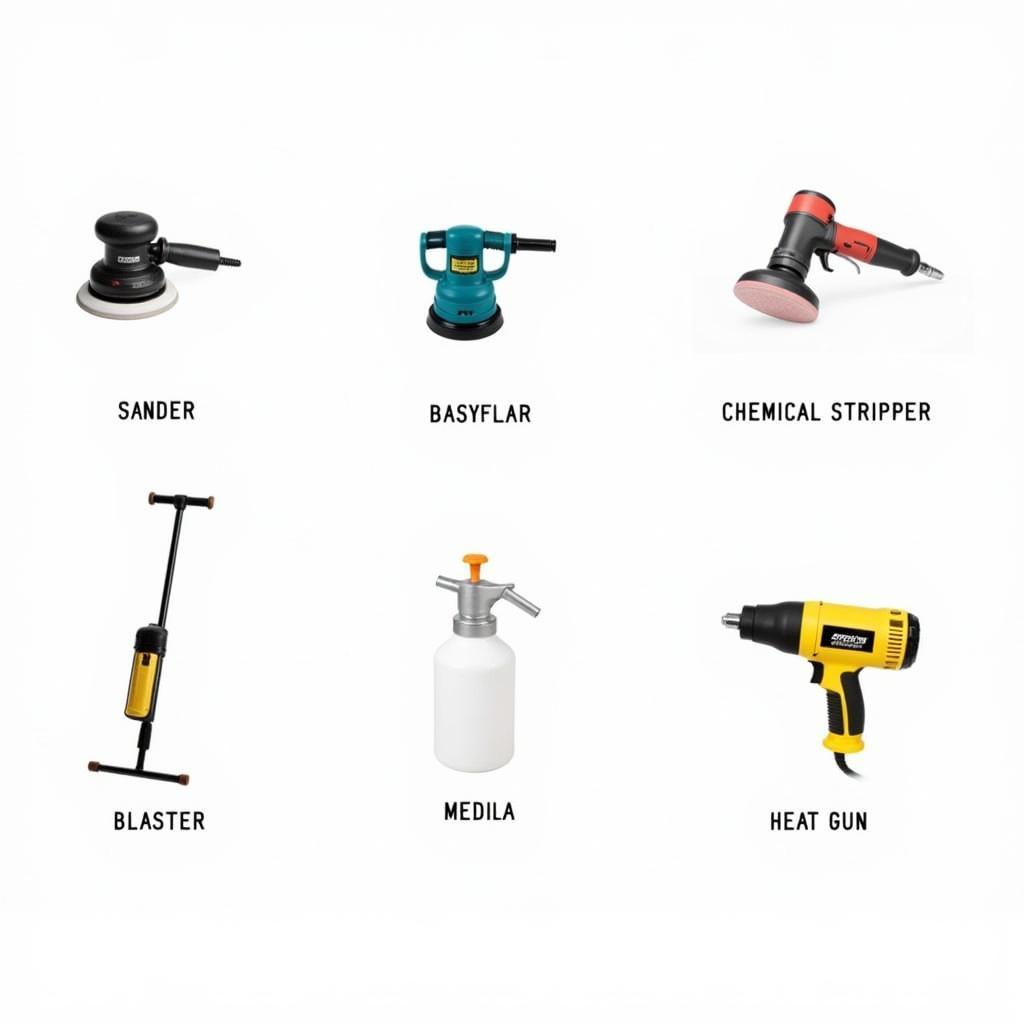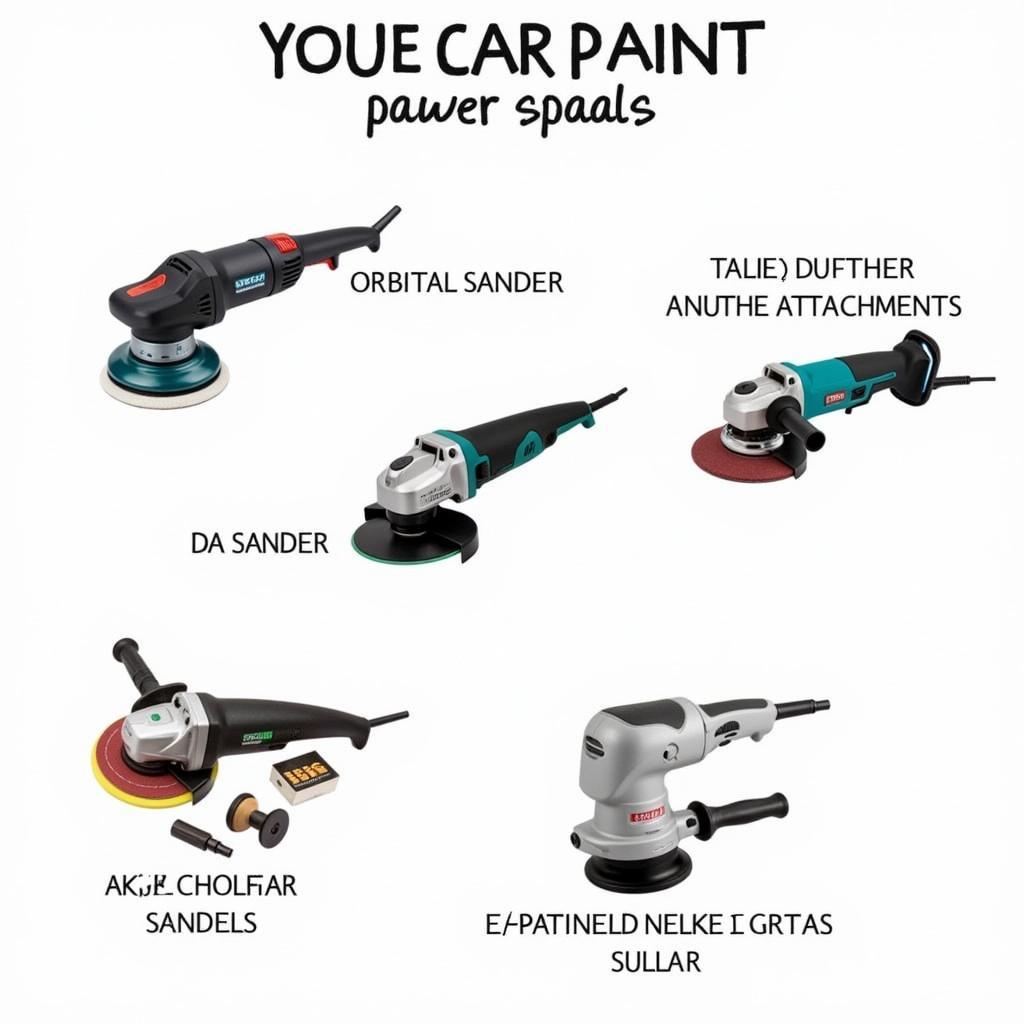Removing paint from a car can be a tricky business. Whether you’re dealing with a small scratch, peeling clear coat, or a full-blown restoration project, choosing the right Tool To Remove Paint On Car is crucial for achieving professional results. This guide will explore the various methods and tools available, helping you make the best decision for your specific needs.
Understanding Your Paint Removal Needs
Before diving into the world of paint removal tools, it’s essential to assess the task at hand. What type of paint are you removing? How much paint needs to be removed? What is the underlying surface material? Answering these questions will help you narrow down your options and choose the most appropriate tool. Are you prepping for a new paint job, removing graffiti, or tackling rust repair? Each scenario requires a different approach.
Types of Paint Removal Tools
 Overview of different paint removal tools for cars
Overview of different paint removal tools for cars
There’s a wide range of tools designed for paint removal, each with its own strengths and weaknesses. From manual scrapers to sophisticated blasting equipment, understanding the differences is key to achieving a smooth, damage-free surface. Here’s a breakdown of common options:
- Chemical Strippers: Ideal for removing multiple layers of paint, especially on intricate surfaces. However, they can be messy and require careful handling due to their caustic nature.
- Sanders: Effective for removing thin layers of paint and smoothing surfaces. They range from handheld orbital sanders to larger belt sanders. Choosing the correct grit is vital to prevent damage to the underlying material.
- Media Blasters: These use compressed air to propel abrasive media, like sand or soda, to strip paint. They are powerful but require specialized equipment and safety precautions.
- Heat Guns: Soften paint, making it easier to scrape away. This method is effective for smaller areas but requires caution to avoid scorching the underlying surface.
- Scrapers: Manual scrapers, including plastic razor blades and putty knives, are useful for removing loosened paint after chemical stripping or heat application.
Choosing the Right Tool for the Job
Selecting the best tool to remove car paint depends on several factors:
- Project Size: For small scratches, a car paint remover tool or a heat gun might suffice. Larger projects may necessitate a sander or media blaster.
- Paint Type: Certain chemical strippers are formulated for specific paint types, such as lacquer or enamel.
- Substrate Material: The underlying material dictates which tools are safe to use. A power tool remove paint from car may be suitable for metal, but not for plastic or fiberglass.
- Your Skill Level: Some tools, like media blasters, require experience and specialized knowledge.
“Choosing the correct paint removal tool is paramount for achieving a flawless finish,” says automotive expert, Michael Davis, of Davis Auto Restoration. “Using the wrong tool can lead to irreversible damage, adding time and cost to your project.”
Tips for Effective Paint Removal
- Surface Preparation: Clean the area thoroughly before starting the paint removal process.
- Safety First: Always wear appropriate safety gear, including eye protection, gloves, and a respirator, especially when using chemical strippers or media blasters.
- Test in an Inconspicuous Area: Before applying any method to the entire area, test it on a small, hidden section to ensure it doesn’t damage the underlying surface.
- Patience is Key: Paint removal can be a time-consuming process. Don’t rush it, as this can lead to mistakes and damage. A best tool to remove car paint can make the process easier, but patience is still essential.
Power Tools for Paint Removal: A Deeper Dive
 Different types of power tools for removing car paint, including electric sanders and air-powered tools
Different types of power tools for removing car paint, including electric sanders and air-powered tools
For larger jobs or when speed is essential, cordless power tool remove paint from car options are a significant advantage. These include electric sanders and pneumatic tools.
- Electric Sanders: Orbital and random orbital sanders are excellent choices for removing paint from flat surfaces. Belt sanders are more aggressive and better suited for larger areas, but require careful control to avoid gouging.
- Pneumatic Tools: Air-powered tools like needle scalers and rotary sanders offer powerful paint removal capabilities, particularly for rust removal and stripping multiple layers of paint. However, they require an air compressor and proper safety precautions.
“For professionals, investing in a quality best tool to remove paint from car can significantly improve efficiency and results,” notes automotive refinishing specialist, Sarah Johnson, of Johnson’s Auto Body. “The right tool can make the difference between a tedious chore and a smooth, productive workflow.”
Conclusion
Choosing the right tool to remove paint on car is crucial for a successful project. By understanding the different types of tools available and considering your specific needs, you can achieve professional results. Whether you’re working on a small touch-up or a complete restoration, taking the time to select the appropriate tool will ensure a smooth, damage-free surface, ready for the next stage of your project.
FAQ (Frequently Asked Questions)
- What is the fastest way to remove paint from a car?
- Can I remove paint from plastic car parts?
- What are the safety precautions for using chemical paint strippers?
- How do I dispose of paint stripper waste?
- What is the best tool for removing rust from a car?
- How do I choose the right sandpaper grit for paint removal?
- What is the difference between an orbital sander and a random orbital sander?
For more detailed information, check out our articles on best tool to remove car paint and car paint remover tool.
Need further assistance? Contact us via WhatsApp: +1(641)206-8880, Email: [email protected], or visit our office at 910 Cedar Lane, Chicago, IL 60605, USA. Our customer service team is available 24/7.

Leave a Reply